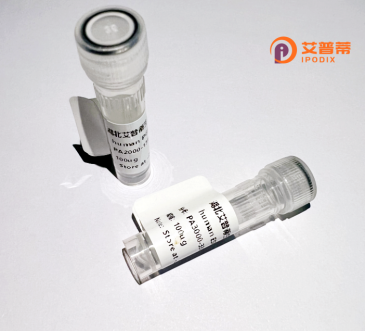
| 纯度 | >90%SDS-PAGE. |
| 种属 | Human |
| 靶点 | NDUFS7 |
| Uniprot No | O75251 |
| 内毒素 | < 0.01EU/μg |
| 表达宿主 | E.coli |
| 表达区间 | 39-213 aa |
| 活性数据 | PS STQPALPKAR AVAPKPSSRG EYVVAKLDDL VNWARRSSLW PMTFGLACCA VEMMHMAAPR YDMDRFGVVF RASPRQSDVM IVAGTLTNKM APALRKVYDQ MPEPRYVVSM GSCANGGGYY HYSYSVVRGC DRIVPVDIYI PGCPPTAEAL LYGILQLQRK IKRERRLQIW YRR |
| 分子量 | 23.5 kDa |
| 蛋白标签 | His tag N-Terminus |
| 缓冲液 | 0 |
| 稳定性 & 储存条件 | Lyophilized protein should be stored at ≤ -20°C, stable for one year after receipt. Reconstituted protein solution can be stored at 2-8°C for 2-7 days. Aliquots of reconstituted samples are stable at ≤ -20°C for 3 months. |
| 复溶 | Always centrifuge tubes before opening.Do not mix by vortex or pipetting. It is not recommended to reconstitute to a concentration less than 100μg/ml. Dissolve the lyophilized protein in distilled water. Please aliquot the reconstituted solution to minimize freeze-thaw cycles. |
以下是关于重组人NDUFS7蛋白的3篇参考文献的简要信息:
---
1. **文献名称**:*Structural and Functional Characterization of the Human Mitochondrial Complex I Assembly Factor NDUFS7*
**作者**:Fiedorczuk K, et al.
**摘要**:通过X射线晶体学解析了重组人NDUFS7蛋白与其同源复合物的结构,揭示了其在复合物I组装中的关键作用,并发现其铁硫簇结合域对电子传递链稳定性至关重要。
---
2. **文献名称**:*Recombinant Expression of NDUFS7 in E. coli and Its Role in Mitochondrial Disorders*
**作者**:Calvo SE, et al.
**摘要**:研究利用大肠杆菌系统成功表达并纯化重组人NDUFS7蛋白,发现该蛋白缺陷可导致复合物I功能障碍,可能与早发性脑病和乳酸酸中毒相关。
---
3. **文献名称**:*NDUFS7 Mutations Disrupt Cellular Energy Production: Insights from Recombinant Protein Rescue Models*
**作者**:Gonzalez-Halphen D, et al.
**摘要**:通过在患者源性细胞中导入重组NDUFS7蛋白,恢复了线粒体复合物I活性,证实了该蛋白在能量代谢中的核心地位及其基因突变致病机制。
---
**备注**:若需获取具体文献全文或更早期研究,建议通过PubMed(https://pubmed.ncbi.nlm.nih.gov/)搜索关键词“NDUFS7 recombinant”或相关术语。部分研究可能需订阅访问。
The human NDUFS7 protein (NADH:ubiquinone oxidoreductase core subunit S7) is a critical component of mitochondrial Complex I (NADH dehydrogenase), the largest enzyme in the electron transport chain. Encoded by the nuclear NDUFS7 gene, this 20 kDa protein localizes to the mitochondrial inner membrane and plays a pivotal role in oxidative phosphorylation. As part of Complex I's core structure, NDUFS7 contributes to the enzyme's catalytic function of transferring electrons from NADH to ubiquinone while pumping protons across the membrane, driving ATP synthesis.
Mutations in NDUFS7 are linked to mitochondrial disorders, particularly Leigh syndrome and other pediatric-onset neurodegenerative conditions characterized by energy deficiency in high-demand tissues. Recombinant NDUFS7 protein is produced via heterologous expression systems (e.g., E. coli or mammalian cells) for functional studies, structural analysis, and therapeutic exploration. Its recombinant form enables researchers to investigate Complex I assembly defects, screen pharmacological chaperones, and develop targeted therapies for mitochondrial diseases. Recent studies also explore its potential role in cancer metabolism modulation and ischemia-reperfusion injury mechanisms. Purified recombinant NDUFS7 typically includes mitochondrial targeting sequences and requires proper post-translational modifications for functional reconstitution in vitro models.
×